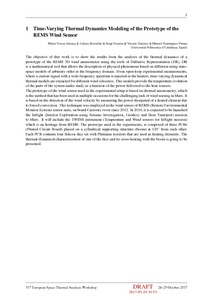Mostra el registre d'ítem simple
Time-varying thermal dynamics modeling of the prototype of the REMS wind sensor
| dc.contributor.author | Atienza García, María Teresa |
| dc.contributor.author | Kowalski, Lukasz |
| dc.contributor.author | Gorreta Mariné, Sergio |
| dc.contributor.author | Jiménez Serres, Vicente |
| dc.contributor.author | Domínguez Pumar, Manuel |
| dc.contributor.other | Universitat Politècnica de Catalunya. Departament d'Enginyeria Electrònica |
| dc.date.accessioned | 2018-04-05T15:38:43Z |
| dc.date.available | 2018-04-05T15:38:43Z |
| dc.date.issued | 2017 |
| dc.identifier.citation | Atienza, M.T., Kowalski, L., Gorreta, S., Jimenez, V., Dominguez, M. Time-varying thermal dynamics modeling of the prototype of the REMS wind sensor. A: European Space Thermal Analysis Workshop. "Proceedings 31st European Thermal Analysis Workshop". 2017. |
| dc.identifier.other | https://exchange.esa.int/download/thermal-workshop/workshop2017/parts/REMS.pdf |
| dc.identifier.uri | http://hdl.handle.net/2117/115983 |
| dc.description.abstract | The objective of this work is to show the results from the analysis of the thermal dynamics of a prototype of the REMS 3D wind anemometer using the tools of Diffusive Representation (DR). DR is a mathematical tool that allows the description of physical phenomena based on diffusion using state- space models of arbitrary order in the frequency domain. From open-loop experimental measurements, where a current signal with a wide frequency spectrum is injected in the heaters, time-varying dynamical thermal models are extracted for different wind velocities. This models provide the temperature evolution of the parts of the system under study as a function of the power delivered to the heat sources. The prototype of the wind sensor used in the experimental setup is based on thermal anemometry, which is the method that has been used in multiple occasions for the challenging task of wind sensing in Mars. It is based on the detection of the wind velocity by measuring the power dissipated of a heated element due to forced convection. This technique was employed in the wind sensor of REMS (Remote Environmental Monitor System) sensor suite, on board Curiosity rover since 2012. In 2018, it is expected to be launched the InSight (Interior Exploration using Seismic Investigation, Geodesy and Heat Transport) mission to Mars. It will include the TWINS instrument (Temperature and Wind sensors for InSight mission) which is an heritage from REMS. The prototype used in the experiments, is composed of three PCBs (Printed Circuit Board) placed on a cylindrical supporting structure (boom) at 120 ¿ from each other. Each PCB contains four Silicon dice set with Platinum resistors that are used as heating elements. The thermal dynamical characterization of one of the dice and its cross-heating with the boom is going to be presented. |
| dc.language.iso | eng |
| dc.rights | Attribution-NonCommercial-NoDerivs 3.0 Spain |
| dc.rights.uri | http://creativecommons.org/licenses/by-nc-nd/3.0/es/ |
| dc.subject | Àrees temàtiques de la UPC::Enginyeria electrònica::Instrumentació i mesura::Sensors i actuadors |
| dc.subject | Àrees temàtiques de la UPC::Física::Termodinàmica |
| dc.title | Time-varying thermal dynamics modeling of the prototype of the REMS wind sensor |
| dc.type | Conference report |
| dc.subject.lemac | Vents -- Mesurament |
| dc.subject.lemac | Detectors |
| dc.contributor.group | Universitat Politècnica de Catalunya. MNT - Grup de Recerca en Micro i Nanotecnologies |
| dc.relation.publisherversion | https://exchange.esa.int/download/thermal-workshop/workshop2017/parts/REMS.pdf |
| dc.rights.access | Open Access |
| local.identifier.drac | 21900509 |
| dc.description.version | Postprint (published version) |
| local.citation.author | Atienza, M.T.; Kowalski, L.; Gorreta, S.; Jimenez, V.; Dominguez, M. |
| local.citation.contributor | European Space Thermal Analysis Workshop |
| local.citation.publicationName | Proceedings 31st European Thermal Analysis Workshop |


